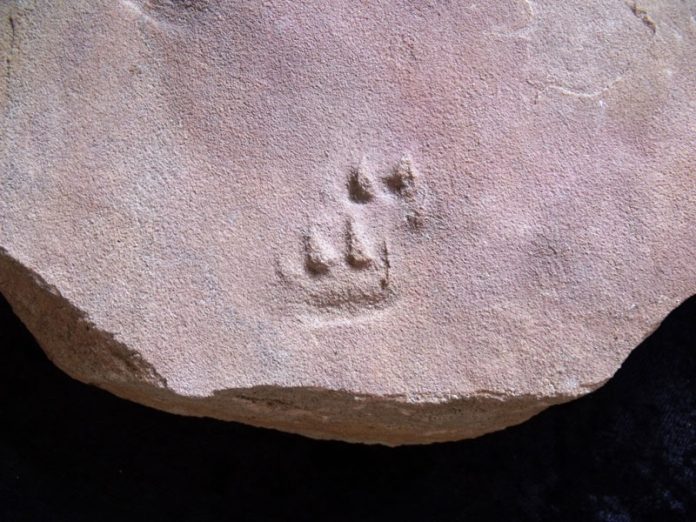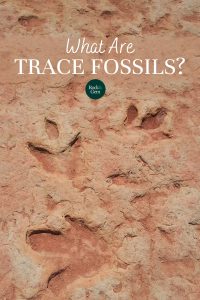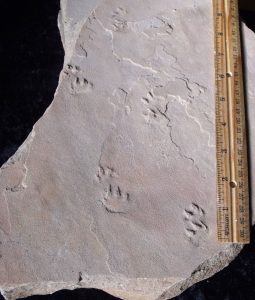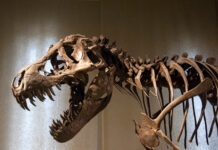
Trace fossils are the fossil tracks, trails and burrows of ancient animals. These are classified as trace fossils or ichnofossils. The word derives from the ancient Greek “ikhnos” which means track or trace. Ichnology is the study of trace fossils.
What Are Ichnofossils?
Unlike when digging for dinosaur bones, Ichnofossils are categorized by their appearance and the implied behavior of the organic nature of their creators. They can be a helpful supplement to discovering more about dinosaurs, including their habits and habitats, and even determining a list of state dinosaurs.

Fossils themselves provide actual evidence through petrified or permineralized remains of shells, bones, leaves, teeth, or other direct evidence of prehistoric life. Ichnofossils are impressions, evidence in the sediment showing some activity by a creature or plant.
Ichnofossils also include feeding marks and coprolites — dino poo for lack of a better word. By slicing into coprolites, paleontologists can sometimes deduce whether the animal was an herbivore or carnivore. If plant material or seeds are found it was a plant eater. If shards of bone are found it was a meat eater. At times it is difficult to determine what specific creature left the evidence. There is also a newer study of urolites caused by the evacuation of liquid waste into softer sediments. Yes, paleontologists see evidence of that sometimes too.
As far as plants are concerned, ichnofossils can be the impressions of leaves though all the leaf material is completely gone. This can also include marks left in sediment showing a leaf or leaves as they blew across the ground. It also includes cavities in the rock where roots grew and decayed.
 How Ichnofossils Formed
How Ichnofossils Formed
It’s easy to understand how plants and animals formed fossils, but it’s a little harder to grasp ichnofossil formation. The formation of ichnofossils requires certain conditions.
First, the sediment must be muddy soft soil or other substrates that can take an impression. The impressions then must dry quickly or be filled with softer sediment for them to be preserved. As the surrounding ground dries and hardens, the tracks are infilled with these softer sediments. The tracks begin to form ichnofossils. Eventually, the sediments turn to stone. Because of erosion, or digging by paleontologists, the tracks are exposed and the softer sediments are removed to reveal the ichnofossil track or trace.
What Ichnofossils Tell Us
Trace fossils can tell us more about the fossil animal than just its bones. In some cases they can tell us if they interacted with other creatures, they could show us confrontations and battles, herding behaviors and so much more.
Animal track ichnofossils can tell paleontologists whether the animals walked in herds or were solitary loners. They can also tell us how fast these animals moved. A mathematical formula has been developed that measures the distance between strides and the estimated length of the leg bones.
Fossil tracks can reveal whether a creature was four-legged or two-legged and if it dragged its tail while it walked. In nearly all cases of dinosaur trackways, no tail swish marks were left in the sediment meaning they did not drag their tails.
Paleontologists can generally also determine the type of creature by looking at the bone structures of the foot bones and the impression of the track in sediment.
Insects and other creatures also left evidence of their passing. Marine trilobites and crabs as well as terrestrial centipedes and millipedes left their footprints in soft sediment. Worms as they dug through sediments left cavities much like worms do today showing us that creatures then did the same as creatures today.
One can only imagine the excitement of paleontologists finding and describing trace fossils. Scientific knowledge and research coupled with imagination allow us to recreate what life was like during prehistoric times. Ichnofossils are an important piece of the puzzle.
This story about trace fossils previously appeared in Rock & Gem magazine. Click here to subscribe. Story by Joseph “PaleoJoe” Kchodl.














